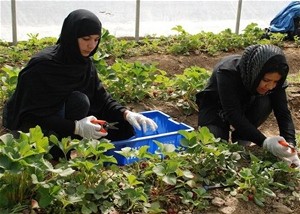
Two women work in one of the greenhouses established by USAID.
USAID/Afghanistan
16 APRIL 2011 | PARWAN PROVINCE, AFGHANISTAN
Many people in Afghanistan live in remote areas without access to local markets for off-season fresh fruit and vegetables. USAID has established three greenhouse facilities in the province of Parwan in central Afghanistan to help provide homemakers with food security and a steady income.
Greenhouses offer rural Afghans the opportunity to grow high-quality produce throughout the year. They are especially attractive for women who can feed their households and generate an income without traveling far from home. USAID is supporting the women in developing a marketing plan and will encourage them to use part of the proceeds of the produce sales in starting other livelihood activities.
Saleha Zareen, the director of the Women’s Agriculture and Livestock Association in Parwan Province, received training on how to establish and maintain greenhouses and is spreading knowledge of the modern agricultural method to the female members of her organization.
“I learned a lot about greenhouses, which is a new technology for the people of Parwan, and I learned about other agricultural methods to use in the greenhouses, like drip irrigation where water goes directly to the roots of the plants for effective water use,” said Zareen.
With the establishment of three greenhouses and the related agricultural training, Zareen said about 25 women are working in each of the greenhouses to support their families. With the ability to produce crops off-season, the women are deriving a higher income from their greenhouse-grown vegetables.
“We have found a new way to support our family and country,” said Zareen. “The idea of greenhouses and the training we have received has proven really useful for the women of our province.”
USAID supports public and private sectors nationwide with the overarching goals of improving agricultural production, increasing sales and exports, generating new jobs, and introducing modern agricultural technologies.







Comment
Make a general inquiry or suggest an improvement.